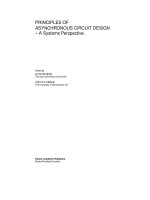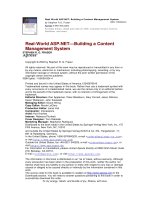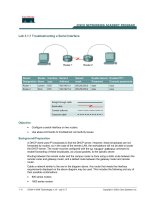Tài liệu Retrieve Unique Records Using Only a Select Query docx
Bạn đang xem bản rút gọn của tài liệu. Xem và tải ngay bản đầy đủ của tài liệu tại đây (19.66 KB, 6 trang )
6.1 Retrieve Unique Records Using Only a Select Query
I need to figure out which customers have invoices. The problem is that when I join the
Customers with the Orders tables, I get the customers listed for each order. I only want
each customer listed once. How do I return only those customers who have orders, but
only once?
Technique
For this How-To, you will be using the DISTINCT clause on a SQL SELECT statement
to limit the data to unique values. When you include the DISTINCT clause, SQL Server
uses the columns that are returned to determine how to limit the data.
For the opposite affect, you can include the ALL clause, although it is not necessary
because this is the default. You will create two SELECT statements for this task. The first
one is for all records:
SELECT Customers.CompanyName FROM Customers INNER JOIN Orders ON
Customers .CustomerID =
Orders.CustomerID
To limit the records, use the DISTINCT clause:
SELECT DISTINCT Customers.CompanyName
FROM Customers
INNER JOIN Orders ON Customers.CustomerID = Orders.CustomerID
Steps
Open and run the Visual Basic .NET-Chapter 6 solution. From the main form, click on
the button with the caption How-To 6.1. When the form loads, you will see two option
buttons, Show All and Distinct, with Show All selected. The SELECT statement showing
an inner join between customers and order is displayed in a Label control. You will also
see a DataGrid control filled with multiple entries of customers displayed (see Figure
6.1).
Figure 6.1. A common problem with inner joins is retrieving multiple records when
you want to see just one per occurrence.
If you click on the option button labeled Use Distinct, then the DataGrid control will be
refreshed, but only one customer per set of orders will be displayed.
1. Create a Windows Form. Then place the controls listed in Table 6.1 with the
following properties set, as displayed in Figures 6.1 and 6.2.
Figure 6.2. Using the DISTINCT clause gives you control over displaying
unique records.
Table 6.1. Control Property Settings for How-To 6.1
Object Property Setting
RadioButton Name rbShowAll
Checked True
RadioButton Name rbDistinct
Label Text SQL Statement
Label Name lblSQLString
Label Text Results
DataGrid Name dgResults
2. As with some of the other chapters' projects, you need to build a support routine to
create the Connection string. Called BuildCnnStr, the function can been seen in
Listing 6.1. This function takes a server and database name passed to it and creates
a connection string.
Listing 6.1 modGeneralRoutines.vb: Creating a Connection String
Function BuildCnnStr(ByVal strServer As String, _
ByVal strDatabase As String) As String
Dim strTemp As String
strTemp = "Provider=SQLOleDB; Data Source=" & strServer & ";"
strTemp &= "Initial Catalog=" & strDatabase & ";"
strTemp &= "Integrated Security=SSPI"
Return strTemp
End Function
Although you could create a routine that would pass back a Connection object, a
more versatile method would be to pass back a string. The reason for this is that
for some objects, you are asked only for a Connection object, but other objects
want just a string.
3. Add the code in Listing 6.2 to the Load event of the form. (Double-click on the
form to bring up the code.)
Listing 6.2 frmHowTo6_1.vb: Loading the Form
Private Sub frmHowTo6_1_Load(ByVal sender As System.Object,
ByVal e As System.EventArgs) Handles MyBase.Load
GenerateData(Me.rbDistinct.Checked)
End Sub
4. Add the code in Listing 6.3 to the class module of the page, creating the
GenerateData routine. This routine creates the necessary SQL SELECT statement
based on whether blnUseDistinct is true or false. If you look back at Listing 6.2,
you will see that this is the value of option button rbDistinct. After the SQL string
is created, it is assigned to lblSQLString to display the string, and then it is used in
a data adapter to fill a dataset. Last, the SQL string is assigned as the data source
for the data grid dgResults.
Listing 6.3 frmHowTo6_1.vb: Building the SQL String for Retrieving the
Data
Sub GenerateData(ByVal blnUseDistinct As Boolean)
' Build the SQL String
Dim strSQL As String
strSQL = "SELECT "
If blnUseDistinct Then
strSQL += "DISTINCT "
End If
strSQL += "Customers.CompanyName FROM Customers "
strSQL += "INNER JOIN Orders ON Customers.CustomerID =
Orders.CustomerID"
' Store the SQL String
Me.lblSQLString.Text = strSQL
' Use the SQL String to build the data adapter and fill the data table.
Dim odaResults As New OleDb.OleDbDataAdapter(Me.lblSQLString.Text,
_
BuildCnnStr("(local)", "Northwind"))
Dim dtResults As New DataTable()
odaResults.Fill(dtResults)
' Assign the data table to the data grid's DataSource property
Me.dgResults.DataSource = dtResults
End Sub
5. Add the code in Listing 5.4 to the CheckChanged event of the rbDistinct Radio
Button control.
Listing 6.4 frmHowTo6_1.vb: Regenerating the Data Based on the Radio
Button That Is Checked
Private Sub rbDistinct_CheckedChanged(ByVal sender As System.Object, _
ByVal e As System.EventArgs) Handles rbDistinct.CheckedChanged
GenerateData(Me.rbDistinct.Checked)
End Sub
Tip
You might have noticed that besides the loading of the form, I
only call the GenerateData routine when the rbDistinct option
button is changed, and not when the rbShowAll option button is
changed. Because only two buttons are available, you only have to
program one of the control's events. If you put it on both, you will
have the routine called twice, which is not a good thing in this
case.
Comments
It is hard to believe that just one word can affect the data that a SQL statement returns.
For the most part, you will want to see all of the records that a SELECT statement
returns, but it is nice to have the DISTINCT clause when you need to limit the data.









